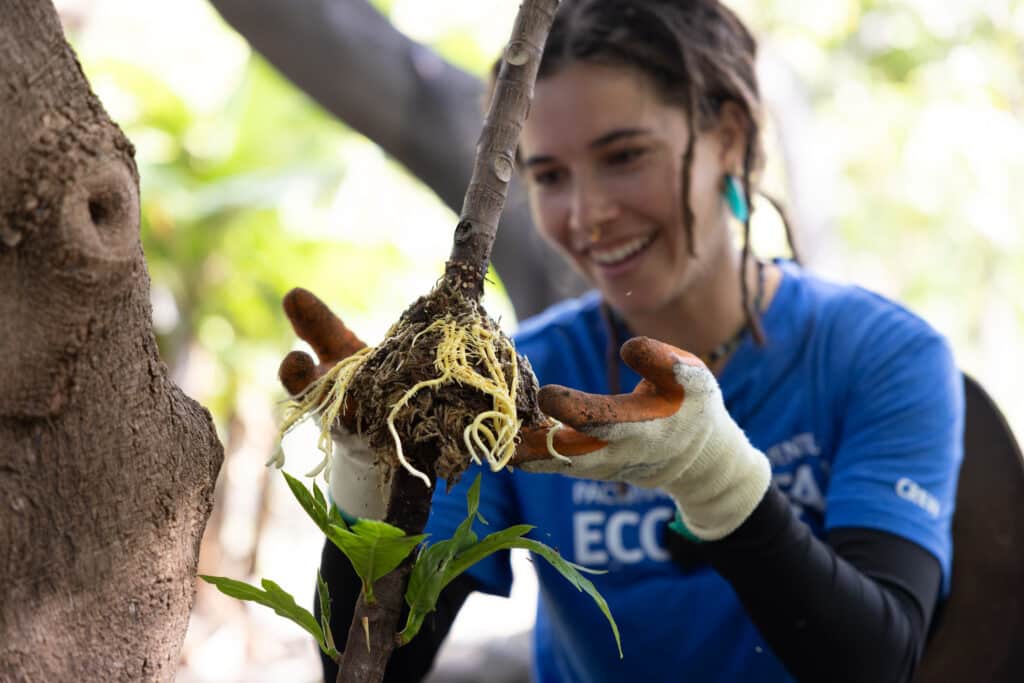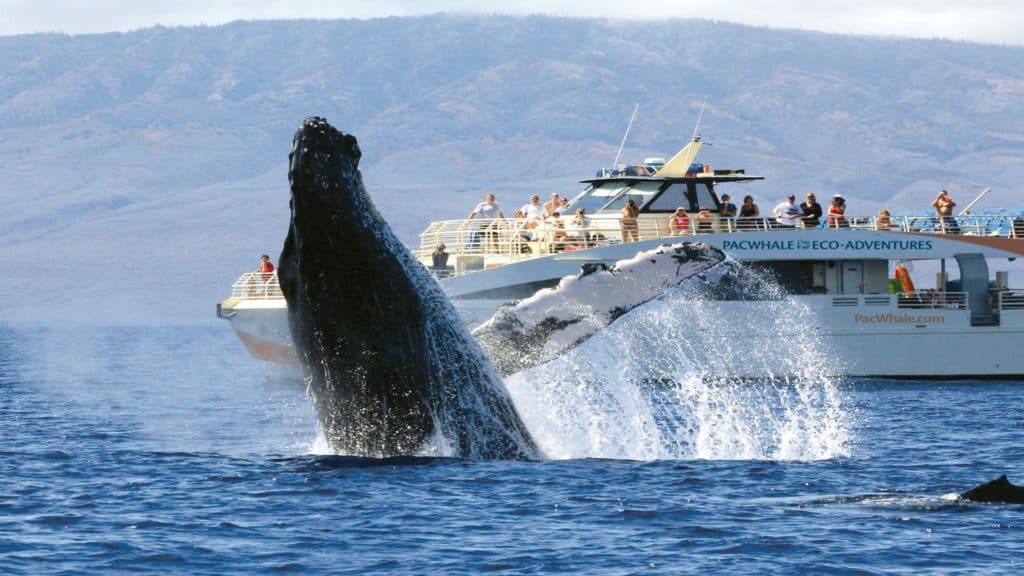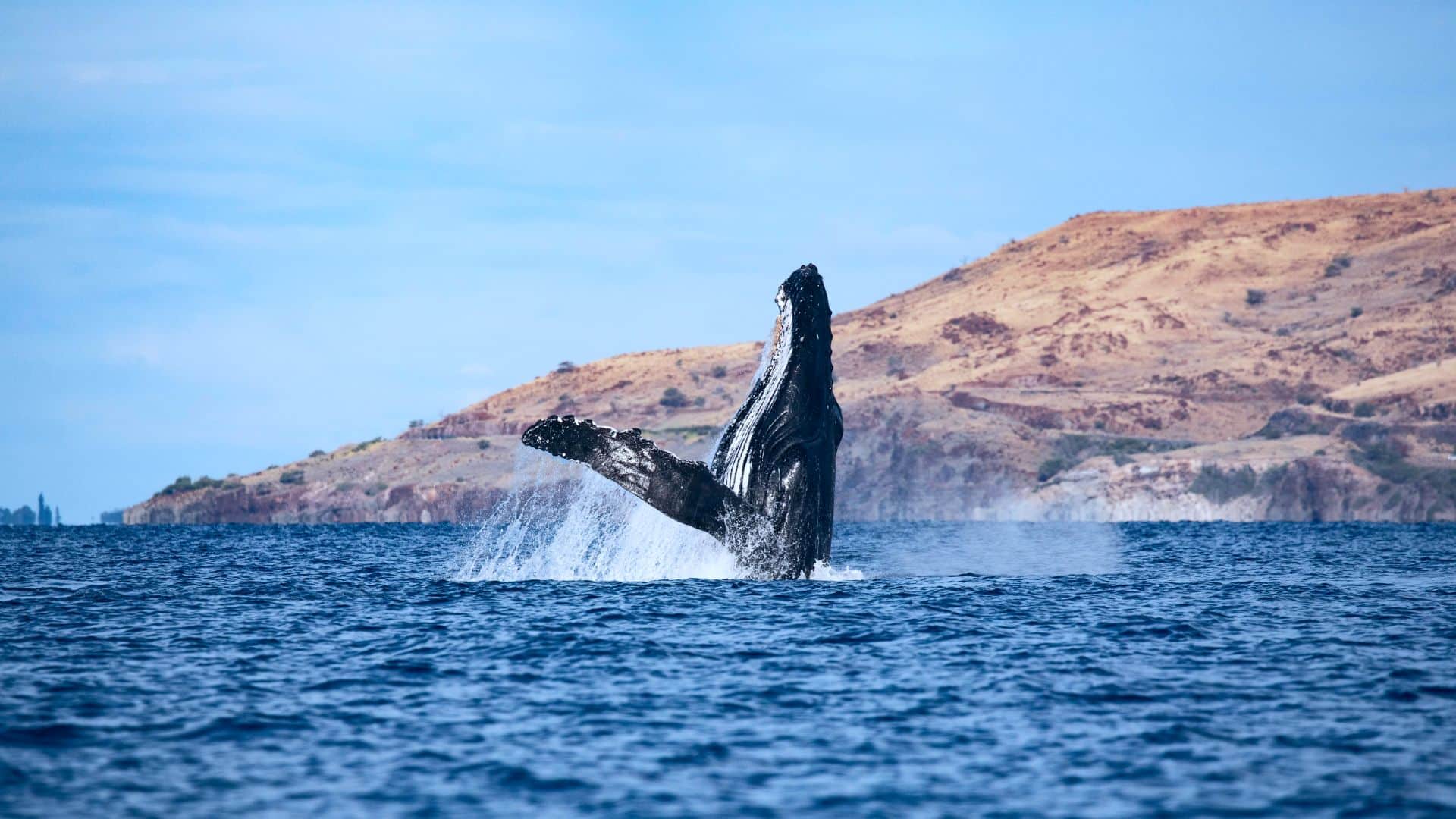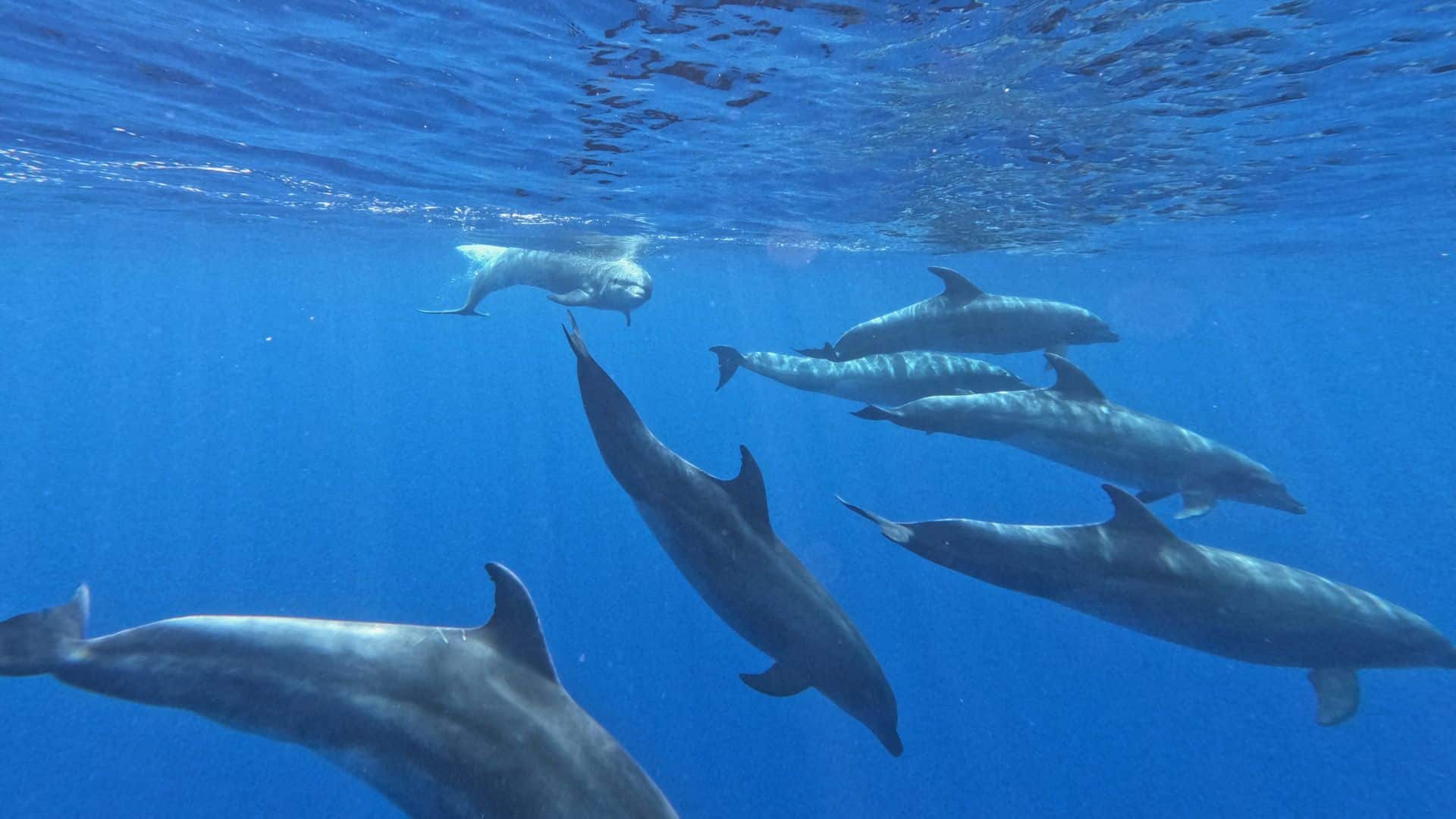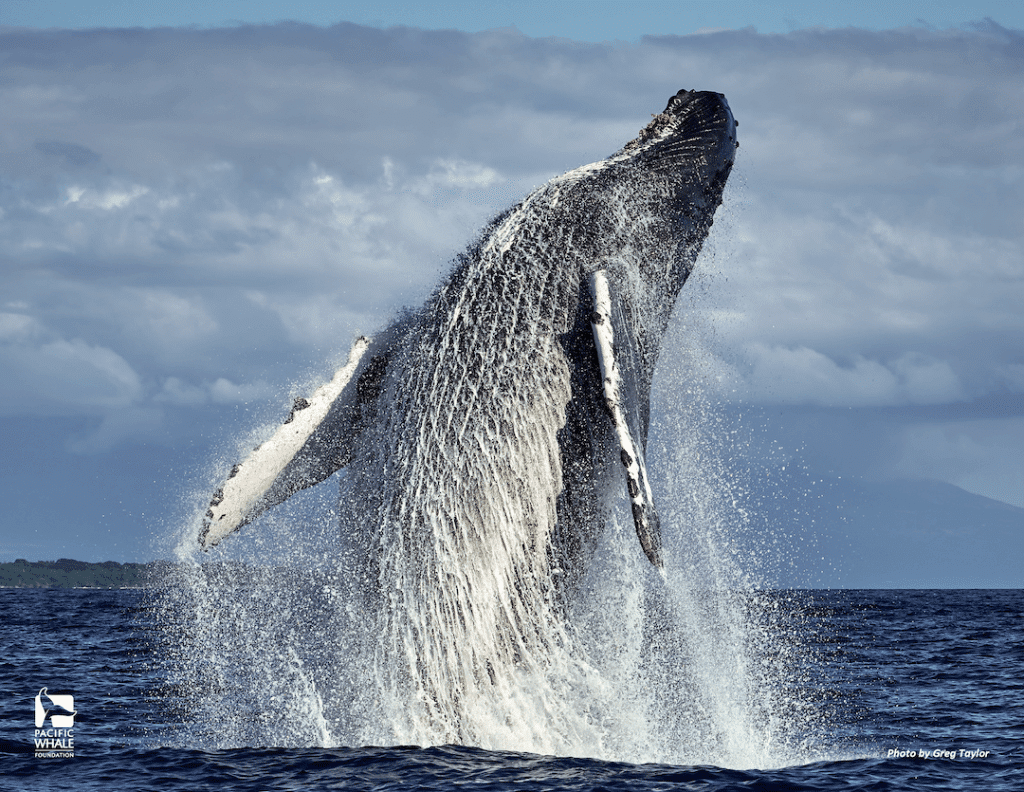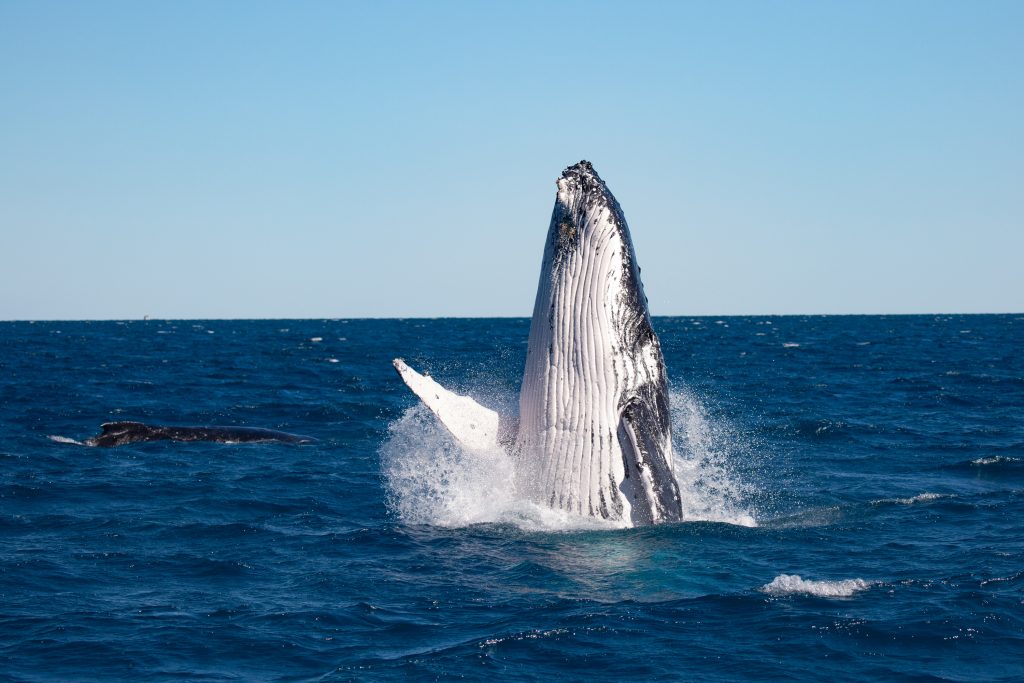In 2021, we made the strategic decision to expand research funding in East Australia, a marine ecoregion where we can grow and deepen our impact, in order to widen our scope of study on marine mammal species.
The first organization to conduct photo-ID research on humpback whales in Queensland’s Hervey Bay, our Australia research has influenced state and commonwealth policies on whale protection in the region. We have since amassed one of the longest running and most comprehensive cetacean photo-ID catalogs in the Southern Hemisphere. This data set is incredibly valuable in detecting changes to the species over time and understanding humpback whale life-history parameters.
Through photo-identification, we have documented migratory movements of the E-1 humpback whale population and have played a key role in discovering interchange occurring between Southern Hemisphere whales. PWF researchers pioneered the documentation of opportunistic humpback whale feeding behavior and have compiled an extensive record of opportunistic feeding in this marine environment.
4 of the 5 major threats we research in this location
Bycatch (Fisheries Interactions)
Recreational fishing, a popular hobby in Queensland waters, encourages commercial fishing operations along the humpback whale migration route and results in the high.potential for marine mammal hooking and entanglements. Additionally, shark nets and baited ‘drumlines’ placed at high-use beaches along Australia’s east coast to protect the public from sharks results in multiple reports annually of humpback whales entangled in shark nets and other fishing gear. Using photographs and drones to assess the degree of dorsal fin scarring and other injuries related to bycatch, we provide data to local government agencies to ensure appropriate mitigation measures and identify potential issues, such as active entanglements, so authorities can launch a response effort.Climate Change
Our long-term data set in Hervey Bay, Australia, in combination with our strategic partners working in Antarctic feeding grounds, enables us to closely monitor and analyze the effects of anthropogenic climate change on humpback whale migration and population dynamics in Australian waters. This critical data allows us to provide science-based recommendations for future mitigation strategies to better protect these magnificent creatures and other marine mammals.Unsustainable Tourism
Swim-with-whale tours conducted in Hervey Bay can negatively impact humpback whales by disrupting natural behaviors in this known resting bay. To better understand the behavioral impact of commercial swim-with-whales tours in Hervey Bay, we conducted targeted research between 2018 and 2020 to determine if humpback whales changed their behavior due to in-water interactions with humans. The project also sought to identify factors which may influence behavior change and provide recommendations to governing authorities, resource managers and tour operators to counter the effect of swim-with-whales tourism on Australia’s humpback whales.The results of the study demonstrated a significant change in whale behavior associated with in-water interactions, most notably a 50% decrease in resting behavior while swimmers are present. Based on these findings, we strongly advocate heightened management of this popular tourism activity in Australia.Vessel Collisions
Hervey Bay experiences a high degree of vessel traffic from commercial fishing vessels, ferries, tour vessels and recreational vessels. The bay is home to several dolphin species and an important resting habitat for humpback whales, particularly mothers and calves. Typical resting behavior involves minimal surface activity, making resting marine mammals difficult to spot from moving vessels. This significantly increases the potential for ship strikes on cetaceans in Hervey Bay. Employing photographs and drone images in our research allows us to assess the degree of scarring linked to vessel interactions on individual cetaceans. We can use this information to inform Australia’s Queensland government if there are certain areas, or times of the year, that constitute a greater threat than others for marine mammals studied.Target Study Species
Recent Publications
2022: The behavioural impacts of commercial swimming with whale tours on humpback whales in Hervey Bay, Australia. S. Stack, K. Sprogis, G. Olson, F. Sullivan, A. Machernis, and J. Currie. The 24th Biennial Conference on the Biology of Marine Mammals, Palm Beach, FL, USA: 1-5 August.
2022: Badhuge, H. Migratory patterns and interchange between breeding grounds by humpback whales (Megaptera novaeangliae) visiting Hervey Bay. Master’s Research Project. Southern Cross University, NSW, Australia (PWF data analyzed). Download PDF
2021: Stack, S.H., Sprogis, K.R., Olson, G.L., Sullivan, F.A., Machernis, A.F. and Currie, J.J. The behavioural impacts of commercial swimming with whale tours on humpback whales (Megaptera novaeangliae) in Hervey Bay, Australia. Frontiers in Marine Science. DOI 10.3389/fmars.2021.696136. Download PDF
2019: Stack, S.H., Currie, J.J., McCordic, J.A., Machernis, A.F. & Olson, G.L. Distribution patterns of east Australia humpback whales (Megaptera novaeangliae) in Hervey Bay, Queensland: a historical perspective. Australian Mammalogy. https://doi.org/10.1071/AM18029. Download PDF
2019: Stack, S.H., McCordic, J.A., Machernis, A.F., Olson, G.L., Currie, J.J. Preliminary report on the impacts of swim-with-whale tourism on humpback whale behavior in Hervey Bay, Queensland, Australia. Document SC/68A/WW/02 presented to the IWC Scientific Committee, Nairobi, Kenya: 10 May-22 May. 22 pp. Download PDF
2019: Vernazzani, B.G., Attard, C.R.M., Barlow, D.R., Burton, C., de Vos, A., Double, M., Gill, P., Jenner, C., Jenner, MN., Möller, L.M., Olson, P., Salgado-Kent, C., & Torres, L.G. Southern Hemisphere Blue Whale Catalogue: preliminary results of IWC comparisons between Australia, New Zealand and Sri Lanka regions. Document SC/68A/SH/04 presented to the IWC Scientific Committee, Nairobi, Kenya: 10 May-22 May. 11 pp. Download PDF
2019: S.H. Stack, J.J. Currie, G.L. Olson and A.F. Machernis. Humpback whales in Hervey Bay: what do we know and how can we protect them? WCA World Whale Conference in Hervey Bay, Australia. October 2019.
2018: Galletti Vernazzani, B., Attard, C., Barlow, D.R., Burton, C., De Vos, A., Double, M., Gill, P., Jenner, K., Jenner, M.N., Moller, L., Olson, P., Salgado-Kent, C., and Torres L.G. Preliminary results of the 2017 IWC Comparisons among Southern Hemisphere Blue Whale Catalogues off Australia, New Zealand, and Sri Lanka regions. Document SC/67B/SH/16 presented to the IWC Scientific Committee, Bled, Slovenia: 24 April – 6 May. 8 pp. Download PDF
2015. Martinez, E., Currie, J.J., Stack, S.H., Easterly, S.K. and Kaufman, G.D. Note on patterns of area use by humpback whales (Megaptera novaeangliae) in 2013 in Hervey Bay, Australia, with an emphasis on mother-calf dyads. Document SC/66a/SH/2 presented to the IWC Scientific Committee, San Diego, USA: 20 May – 4 June. 16 pp.
2014: Constantine, R, Steel, D, Allen, J, Anderson, M, Andrews, O, Baker, CS, Beeman, P, Burns, D, Charrassin, J-B, Childerhouse, S, Double, M, Ensor, P, Franklin, T, Franklin, W, Gales, N, Garrigue, C, Gibbs, N, Harrison, P, Hauser, N, Hutsel, A, Jenner, C, Jenner, M-N, Kaufman, G, Macie, A, Mattila, D, Olavarria, C, Oosterman, A, Paton, D, Poole, M, Robbins, J, Schmitt, N, Stevick, P, Tagarino, A, Thompson, K, and Ward, J. Remote Antarctic feeding ground important for east Australian humpback whales. Marine Biology, 161: 1087-1093. Download PDF
2014: Stack, S.H., Swabb, M.H., Currie, J.J., Kaufman, G.D. and Martinez, E. Match My Whale: A crowdsourcing platform for cross-identification of Australian humpback whales (Megaptera novaeangliae). Document SC/65b/SH10 presented to the IWC Scientific Committee, Bled, Slovenia: 12-24 May. 4 pp.
2013: Rankin, R.W., Maldini, D. and Kaufman, G. Bayesian estimate of Australian humpback whale calving interval under sparse resighting rates: 1987 – 2009. Journal of Cetacean Research Management: 13(2):109-12. Download PDF
2013: Kaufman, G.D. and Kaufman, P.M. Summary results of a survey conducted during the 2012 whalewatching season in Hervey Bay, Australia. Document SC/65a/WW05 presented to the IWC Scientific Committee, Jeju, Korea: 3 June – 15 June. 18 pp.
2011: Forestell, P.H., Kaufman, G.D. and Chaloupka, M. Long term trends in abundance of humpback whales in Hervey Bay, Australia. Journal of Cetacean Research Management (Special Issue 3): 237-241. Download PDF
2011: Kaufman, G.D., Silva, I.F., Hutsel, A., Macie, A., Maldini, D., and Rankin, R.W. Mid-migration humpback whale feeding behavior off Eden, NSW, Australia. The 19th Biennial Conference on the Biology of Marine Mammals, Tampa, FL, USA: 26 November – 2 December.
2011: Kaufman, M., Kaufman, G., Coughran, D., Allen, J., Burns, D., Burton, C., Castro, C., Constantine, R., Childerhouse, S.,Franklin, T., Franklin, W., Forestell, P., Gales, R., Garrigue, G., Gibbs, N., Jenner, C., Paton, D., Noad, M., Robbins, J., Slooten, E., Smith, F. and Stevick, P. Photographic evidence of interchange between east Australia (BS E-1) and West Australia (BS- D) humpback whale breeding populations. The 19th Biennial Conference on the Biology of Marine Mammals, Tampa, FL, USA: 26 November – 2 December.
2010: Hoffman, W.S, Kaufman, G.D. and Jule, K. Estimation of Survival, Recruitment and Realized Growth Rates of the East Australia Humpback Population (BS-1) Using Temporal Symmetry Models. 14a Reunião de Trabalho de Especialistas em Mamíferos Aquáticos da América do Sul y 8o Congresso da Sociedade Latinoamericana de Especialistas em Mamíferos Aquáticos, Florianópolis, Santa Catarina, Brazil: 24-28 October.
2010: Jule, K. and Kaufman, G. Greenhouse effect? Evidence of apparent sun damage to East Australian humpback whales (Megaptera novaeangliae). 14a Reunião de Trabalho de Especialistas em Mamíferos Aquáticos da América do Sul y 8o Congresso da Sociedade Latinoamericana de Especialistas em Mamíferos Aquáticos, Florianópolis, Santa Catarina, Brazil: 24-28 October.
2010: Kaufman, G., Forestell, P., Coughran, D. and Allen, J. The First Photographic Evidence of Interchange Between East Australia (BS E-1) and West Australia (BS – D) Breeding Populations. 14a Reunião de Trabalho de Especialistas em Mamíferos Aquáticos da América do Sul y 8o Congresso da Sociedade Latinoamericana de Especialistas em Mamíferos Aquáticos, Florianópolis, Santa Catarina, Brazil: 24-28 October.
2009: Gibson, Q., Kaufman, G. and Forestell, F. Two may be better than one: Association among east Australian Humpback whale (Megaptera novaeangliae) mother-calf pairs on the southward migration. The 18th Biennial Conference on the Biology of Marine Mammals, Quebec, Canada: 12-16 October.
2008: Gibson, Q., Kaufman, G. and Forestell, P. Two may be better than one: Association among east Australian Humpback whale (Megaptera novaeangliae) mother-calf pairs on the southward migration. XIII Reunion de trabajo de Especialistas en Mamiferos Aquaticos del Sur y 7° Congreso SOLAMAC, Montevideo, Uruguay, 13-17 November.
2006: Forestell, P., Kaufman, G., Mallo, A. and Lehman, S. Indices e Intervalos de Nacimientos de Hembras de Ballenas Jorobadas Foto-Identificadas en las Costas del Este de Australia, 1984 – 2005. La Reunión International sobre el Estudio de los Mamíferos Acuáticos, Mérida, Yucután, México: 5-9 November.
2006: Kaufman, G.D., Forestell, P.H., Butt, R. and Lehman, S. The Importance of Eden, NSW as an Opportunistic Feeding Area for Southbound East Australian Humpback Whales. DEH Australia: Cetacean Research Priorities Conference, Adelaide, South Australia, Australia: 21-22 February.
2006: Rock, J., Pastene, L.A., Kaufman, G., Forestell, P., Matsuoka, K. and Allen, J. A note on East Australia Group V Stock humpback whale movement between feeding and breeding areas based on photo-identification. Journal of Cetacean Research and Management, 8: 301-305. Download PDF
2011: Kaufman, G., Coughran, D., Allen, J.M., Burns, D., Burton, C., Castro, C., Childerhouse, S., Constantine, R., Franklin, T., Franklin, W., Forestell, P., Gales, R., Garrigue, C., Gibbs, N., Jenner, C., Paton, D., Noad, M., Robbins, J., Slooten, E., Smith, F. and Stevick, P. Photographic evidence of interchange between east Australia (BS E-1) and West Australia (BS -D) humpback whale breeding populations. Document SC/63/SH11 presented to the IWC Scientific Committee, Tromso, Norway: 11-14 July. 13 pp.
2011: Silva, I.F., Kaufman, G.D., Hutsel, A., Macie, A., Maldini, D. and Rankin, R. Mid-migration humpback whale feeding behavior off Eden, NSW, Australia. Document SC/63/SH12 presented to the IWC Scientific Committee, Tromso, Norway: 11-14 July. 17 pp.
2010: Hoffman, W.S., Kaufman, G.D. and Jule, K. 2010. Estimation of Survival, Recruitment and Realized Growth Rates of the East Australia Humpback Population (BS-1) Using Temporal Symmetry Models. Document SC/62/SH14 presented to the IWC Scientific Committee, Agadir, Morocco: 21-25 June. 17 pp.
2009-2010: Humpback Whale Photo-Identification Surveys in the Cairns/Cooktown and Whitsunday Islands Management Areas. Annual Report to the Great Barrier Reef Marine Park Authority, Queensland, Australia.
2009: Gibson, Q., Kaufman, G. and Forestell, P. Status Report: Photo-Identification of Humpback Whales at Multiple Aggregation Areas along east coast Australia. Document SC/61/SH25 presented to the IWC Scientific Committee, Madeira, Portugal: 22-25 June. 12 pp.
2006: Castro, C., Félix, F., Forestell, P., Haase, B., Kaufman, G. and Scheidat, M. Site fidelity of humpback whales (Megaptera novaeangliae) in Ecuador between 1991-2004, based on photo-identification. Document SC/A06/HW8 presented to the IWC Intersessional Workshop on Comprehensive Assessment of Southern Hemisphere Humpback Whales, Hobart, Tasmania, Australia, 3-7 April.
2006: Félix, F., Castro, C., Hasse, B., Forestell, P., Alava, J.J. and Scheidat, M. Estimates of the Southeastern Pacific Humpback Whale Stock with Mark-Recapture Models in Ecuador. Document SC/A06/HW13 presented to the IWC Intersessional Workshop on Comprehensive Assessment of Southern Hemisphere Humpback Whales, Hobart, Tasmania, Australia, 3-7 April. 7 pp.
2006: Forestell, P.H., Kaufman, G.D. and Chaloupka, M. Abundance estimate of humpback whales in Hervey bay, Australia, based on CMR profiles, 1988– 2002. Document SC/A06/HW17 presented to the IWC Intersessional Workshop on Comprehensive Assessment of Southern Hemisphere Humpback Whales, Hobart, Tasmania, Australia: 3-7 April.
2006: Forestell, P.H., Kaufman, G.D., Mallo, A. and Lehmann, S. Calving rates and intervals for east Australia female humpback whales, based on individual photo-identifications: 1984-2005. Document SC/A06/HW23 presented to the IWC Intersessional Workshop on Comprehensive Assessment of Southern Hemisphere Humpback Whales, Hobart, Tasmania, Australia, 3-7 April. 9 pp.
2004: Naessig, P.J. and Lanyon, J.M. Levels and probable origin of predatory scarring on humpback whales (Megaptera novaeangliae) in east Australian waters. Wildlife Research, 31: 163-170. Download PDF
2004: Naessig P.J. Levels and probable origin of predatory scarring on humpback whales (Megaptera novaeangliae) in east Australian waters. Bachelor Honors. The University of Queensland, Brisbane, Australia.
2003-present: Humpback Whale Photo-Identification Survey of Hervey Bay Marine Park. Annual Report to Queensland Parks and Wildlife Service, Maryborough, Queensland, Australia.
2003: Forestell, P.H., Kaufman, G.D. and Chaloupka, M. Migratory characteristics of humpback whales (Megaptera novaeangliae) in Hervey Bay and the Whitsunday Islands, Queensland, Australia: 1993-1999. Final Report to the Environment Protection Agency, Queensland Parks and Wildlife Service, Brisbane, Queensland, Australia.
2001: Forestell, P.H., Paton, D.A., Hodda, P. and Kaufman, G.D. Observations of a hypo-pigmented humpback whale (Megaptera novaeangliae) off east coast Australia: 1991- 2000. Memoirs of the Queensland Museum, 47: 437-450. Download PDF
2001: Kaufman, G.D. Humpback Whale Photo-Identification Survey of Hervey Bay: 2000 Season. Annual Report to Queensland Parks and Wildlife Service, Maryborough, Queensland, Australia.
2000: Garrigue, C., Forestell, P., Greaves, J., Gill, P., Naessig, P., Patenaude, N. and Baker, S.C. Migratory movement of humpback whales (Megaptera novaeangliae) between New Caledonia, East Australia and New Zealand. Journal of Cetacean Research and Management, 2(2): 000-000. Download PDF
2000: Baird, R.W. and Burkhart, S.M. Bias and variability in distance estimation on the water: Implications for the management of whale watching. Document SC/52/WW1 presented to the IWC Scientific Committee, Adelaide, Australia, 3-6 July. 10 pp.
2000: Forestell, P.H., Paton, D. and Hodda, P. Multiple Sightings of an All-White Humpback Whale Along the East Coast of Australia, 1991- 1999. The Queensland Museum Humpback Whale 2000 Conference, Brisbane, Queensland, Australia: 29 August – 1 September.
2000: Kaufman, G.D., Naessig, P., Forestell, P.H. and Chaloupka, M. Estimates of group size and rates of interchange between humpback whales in the Whitsunday Islands and Hervey Bay, Queensland, Australia. The Queensland Museum Humpback Whale 2000 Conference, Brisbane, Queensland, Australia: 29 August – 1 September.
2000: Kaufman, G.D. and Naessig, P. Observations of humpback whales feeding off Eden, NSW, Australia. The Queensland Museum Humpback Whale 2000 Conference, Brisbane, Queensland, Australia: 29 August – 1 September.
1999: Naessig, P. Levels and Origin of Predatory Scarring on Humpback Whales in East Australian Waters. The 13th Biennial Conference on the Biology of Marine Mammals, Maui, HI, USA, 29 November – 3 December.
1999: Chaloupka, M., Osmond, M. and Kaufman, G. Estimating seasonal abundance trends and survival rates of humpback whales in Hervey Bay (east coast Australia). Marine Ecology Progress Series, 184: 291-301. Download PDF
1996-2000: Naessig, P.J. and Kaufman, G.D. Humpback Whale Photo-Identification Survey of the Whitsunday Islands and Hervey Bay. Annual Report to Department of Environment, Brisbane, Queensland, Australia.
1995: Forestell, P.H. and Brown, E.K. Feasibility study on shore-based observations of humpback whale distribution and behaviour patterns in Hervey Bay Marine Park, Australia. Final Report to the Department of Environment and Heritage, Hervey Bay Marine Park, Maryborough, Queensland, Australia.
1995: Forestell, P.H. and Kaufman, G.D. Development of Whalewatching in Hawaii and its Application as a Model for Growth and Development of the Industry Elsewhere. Encounters With Whales, Hervey Bay, Queensland, Australia: 26-30 July.
1995: Orams, M.B. and Forestell, P.H. From Whale Harvesting to whalewatching: Tangalooma 30 Years on. In: Bellwood, O. and Choat, H., and N. Saxena (eds.) Recent Advances in Marine Science and Technology, ’94, James Cook University, Townsville, Australia. 107-113. Download PDF
1994-1995: Forestell, P.H. and Kaufman, G.D. Humpback Whale Photo-Identification Survey of the Whitsunday Islands. Annual Report to Department of Environment and Heritage, Brisbane, Queensland, Australia..
1993: Forestell, P.H., Brown, E.K. and Kaufman, G.D. Spatial and temporal use of Hervey Bay Marine Park by humpback whales and boats: 1992. Final Report to Department of Environment and Heritage, Hervey Bay Marine Park, Maryborough, Queensland, Australia
1993: Kaufman, G.D., Lagerquist, B.A., Forestell, P.H. and Osmond, M.G. Humpback Whales of Australia: A Catalogue of Individual Whales Identified by Fluke Photographs. Queensland Department of Environment and Heritage, Brisbane, Australia.
1994: Forestell, P.H. and Kaufman, G.D. Resource managers and field researchers: Allies or adversaries? Encounters With Whales Workshop. Great Barrier Reef Marine Park Authority, Townsville, Australia.
1994: Forestell, P.H. and Kaufman, G.D. Helping Those Who Help Those Who Watch The Whales. Pacific Congress on Marine Science and Technology (PACON 94), Townsville, Queensland, Australia: July.
1993: Forestell, P.H. In the Wake of the Whale: Studying the Migration of Individually Identified Humpback Whales Along the East Coast of Australia. Conference of Marine Education Society of Australasia, Brisbane, Queensland, Australia: 29 September.
1993: Kaufman, G.D. and Forestell, P.H. Marine mammals and boats in Hervey Bay Marine Park, Queensland, Australia, as determined by aerial surveys. The 10th Biennial Conference on the Biology of Marine Mammals, Galveston, TX, USA: 11-15 November.
1993: Kaufman, G.D. and Forestell, P.H. The role of research in the development of the whalewatching industry. Invited presentation at Encounters with Whales Conference, Lady Elliot Island, Australia: 7 September.
1991: Kaufman, G.D., Krutzikowsky, G.K. and Lagerquist, B.A. Reproductive profiles of female humpback whales off east Australia. The 9th Biennial Conference on the Biology of Marine Mammals, Chicago, IL, USA: 5-9 December.
1991: Krutzikowsky, G.K., Forestell, P.H., Kaufman, G.D. and Lagerquist, B.A. Migratory timing of east Australian female humpback whales with and without calves. The 9th Biennial Conference on the Biology of Marine Mammals, Chicago, IL, USA: 5-9 December.
1990: Forestell, P.H. and Kaufman, G.D. Whalewatching in Hervey Bay, Australia and its role in enhancing public appreciation for endangered species. The Queensland Museum Humpback Whale Conference, Brisbane, Australia: 27-28 September.
1990: Forestell, P.H. and Kaufman, G.D. Whalewatching in Hervey Bay, Australia and its role in enhancing public appreciation for endangered species. The Queensland Museum Humpback Whale Conference, Brisbane, Australia: 27-28 September.
1990: Forestell, P.H., Kaufman, G.D., Lagerquist, B. and Krutzikowsky, G. An examination of bio-geographical factors associated with the presence of humpback whales in Hervey Bay, Australia. The Queensland Museum Humpback Whale Conference, Brisbane, Australia: 27-28 September.
1990: Kaufman, G.D., Osmond, M., Lagerquist, B. and Forestell, P.H. Humpback whales of Australia: A catalogue of individuals identified by fluke and lateral body photographs. The Queensland Museum Humpback Whale Conference, Brisbane, Australia: 27-28 September.
1990-1996: Survey of the Humpback Whales Photographically Identified off Perth. Annual Report to Department of Conservation and Land Management, Como, West Australia, Australia.
1990: Kaufman, G.D., Osmond, M. G., Ward, A. J. and Forestell, P.H. Photographic documentation of migratory movement of a humpback whale (Megaptera novaeangliae) between east Australia and Antarctic Area V. Document SC/A88/ID41 Report to the International Whaling Commission (Special Issue 12): 265-267.
1989: Krutzikowsky, G.K., Forestell, P.H. and Kaufman, G.D. An analysis of humpback whale activity in Hervey Bay, Australia during the southward migration. The 8th Biennial Conference on the Biology of Marine Mammals, Monterey, CA, USA: 7-11 December.
1988-1992: Humpback Whale Photo-Identification Survey of Hervey Bay. Annual Report to Environment and Heritage, Brisbane, Queensland, Australia.
1988: Kaufman, G.D., Osmond, M.G., Ward, A. J. and Forestell, P.H. Photographic documentation of the migratory movement of a humpback whale (Megaptera novaeangliae) between East Australia and Antarctic Area V. Document SC/A88/ID41 (Special Issue 12): 265-267.
1988: Kaufman, G.D., Osmond, M. and Chaloupka, M. Use of lateral body and fluke pigmentation patterns in population estimates of east Australian (Area V) humpback whales. Symposium on the Use of Non-lethal Techniques, Especially Photo-identification Techniques to Estimate Cetacean Population Parameters, La Jolla, CA, USA: 29 April – 1 May.
1987: Kaufman, G.D. and Osmond, M. Aspects of population dynamics of east Australian humpback whales. The 7th Biennial Conference on the Biology of Marine Mammals, Miami, FL, USA: 5-9 December.
1987: Kaufman, G.D. Photo-identification of Humpback Whales in Australian Waters. Symposium on Marine Mammals of Australasia, Royal Zoological Society of New South Wales, Sydney, Australia: 8-10 August.
1987: Kaufman, G.D., Smultea, M.A. and Forestell P. Use of lateral body pigmentation patterns for photo identification of east Australian (Area V) humpback whales. Cetus,7: 5-13. Download PDF
1985: Kaufman, G.D. Photographic fluke and lateral body identification of Australian humpback whales. The 6th Biennial Conference on the Biology of Marine Mammals, Vancouver, B.C., Canada: 22-26 November.
1985: Kaufman, G.D. and Jenkins, P.F. Comparisons of Australian and Hawaiian humpback whale songs. The 6th Biennial Conference on the Biology of Marine Mammals, Vancouver, B.C., Canada: 22-26 November.
1985: Kaufman, G.D., Sneath, H. and Slade, R. Migratory characteristics of east Australian humpback whales. The 6th Biennial Conference on the Biology of Marine Mammals, Vancouver, B.C., Canada: 22-26 November.
1984-1997: Survey of the Humpback Whales Photographically Identified Australian Waters. Annual Report to Nature Conservation Agency, Canberra, Australia.
1984-present: Pacific Whale Foundation Annual Australia Research, Progress report on cetacean research, with statistical data for the calendar year. Annual Australian Progress Report on Cetacean Research (SC/Prog.Rep.) to the International Whaling Commission.
